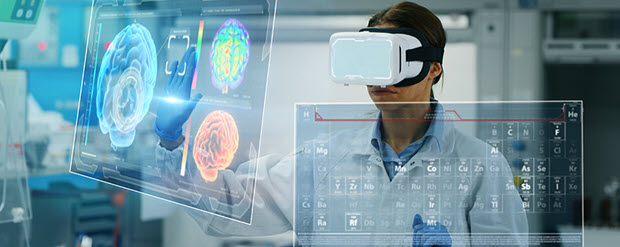


Augmented Reality (AR) is a combination of virtual and real worlds. It may seem that AR is a recent technological achievement but in fact, its development started in the 1960s. Although there is still a lot of space for improvements to technology, humanity has already created amazing things using it.
AR is mostly known as an entertainment tool. At the same time, there are spheres where its impact becomes not just game-changing, but even life-saving.
Since healthcare has a great influence on the quality and duration of our lives, it is one of the first spheres where we try to utilize all the discoveries and inventions. The same happened to AR, and it turned out to be a promising match. Let’s now see what opportunities AR brings to the healthcare industry.
AR applications allow putting together and visualizing all the patient’s information, such as symptoms and results of different medical diagnosis. It reduces the risk of mistakes as well as improves and simplifies sharing this information with colleagues around the world.
There are also AR applications for helping with common procedures that may cause difficulties, for example, IV (intravenous injection). If you have ever experienced a nurse failing to find your vein at the first attempt, you will definitely appreciate AccuVein. It is an AR app that scans a patient’s skin and then shows a nurse where exactly the veins are.

It is a common situation when patients face difficulties describing their symptoms or understanding what is going on inside their bodies after being diagnosed. The main reason is the lack of knowledge of medical terminology or of medicine in general. AR apps can become a bridge between doctors and their patients by visualizing body parts, organs, and different inner processes. The same works for understanding more about the treatment the patient is about to undergo: all the active ingredients of pills, their effects, and the influence of different procedures can be visualized and easily explained.
Here is one more example of implementing augmented reality in healthcare education: it can be used for training medical students and improving the qualifications of practicians. Most often surgical or any other operations are practiced at mannequins or models. But AR can provide a more realistic and involving experience by 3D visualization of real-life cases.
AR apps like Proximie or EchoPixel are also considered as robust tools for simplifying surgeries and reducing the possibility of human error. They have great value: for example, in surgical planning where they allow overlaying all the important images like MRI data or CT scans directly onto the patient’s body with the help of smart devices like Google Glass or Microsoft HoloLens. This overlayed visualization enormously helps during the surgical procedures: surgeons can see muscles, bones, blood vessels, tumors, and internal organs without making a single incision. The same as with diagnostics, these images can be shared with colleagues from different countries during complex operations to combine knowledge and skills for delivering a better result.
AR can significantly help with the post-operational care and looking for patients who have difficulties meeting doctors in-person (living in remote regions, disabled or elderly people). For example, patients can use digital demonstrations empowered by AR for redeveloping fine motor skills. The research of the University of Tasmania has shown that this approach provides positive results faster than face-to-face demonstrations.

